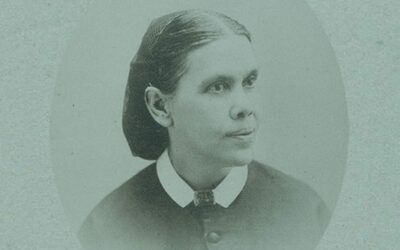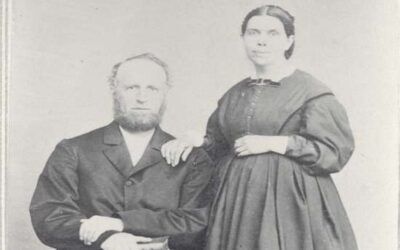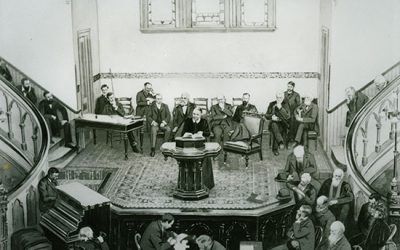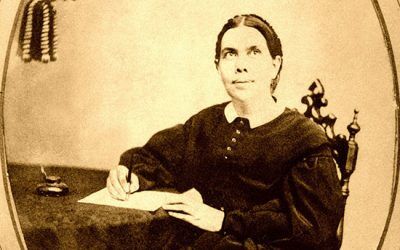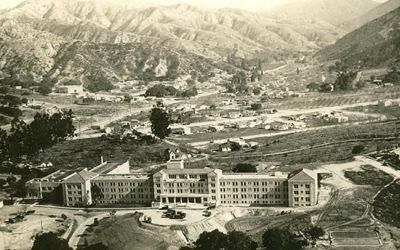Ellen G. White’s contributions to the formation and growth of the Seventh-day Adventist Church are an integral part of its history. As a significant co-founder of the denomination, her writings provided millions of people with practical and spiritual counsel. So to preserve and manage this literary legacy, the Ellen G. White Estate was established as outlined in her last will.
But this organization is more than just an archive or a library. The White Estate also serves as a place of learning about the early history of the Adventist Church. So if you’re ever in Silver Spring, Maryland, you can even stop by to tour the museum inside the Ellen G. White Visitor Center.
A big part of the White Estate’s mission is to be a helpful resource for anyone who wants to understand more about Adventist history, Ellen White, and her extensive, widely-influential ministry.
Let’s learn more about how the White Estate operates and why it’s so highly valued by Adventists. We will cover:
Let’s start with some historical background.
How was the Ellen G. White Estate established?
Photo by Debby Hudson on Unsplash
As she faced the later years of her life, Ellen White considered what might be the best way to manage the preservation of her written works. So when she established her will in 1912, she also laid out the framework for this estate. As specified in her will, the organization would have a four-part purpose:
- Acting as her legal agent by holding custody and copyright of her writings
- Conducting any business related to her writings
- Securing the printing of new translations, whether modernizations of wording or translations into other languages like Spanish, Portuguese, or French
- Printing of compilations from [her] manuscripts, such as books like The Adventist Home1
Ellen White also listed the names of those she wished to be on the first board of trustees: Arthur G. Daniells, William C. White (her son), Clarence C. Crisler, Charles H. Jones, and Francis M. Wilcox.2
When she passed away in 1915, the Estate was established.3
It had its beginnings at Ellen White’s final home, known as “Elmshaven,” in St. Helena, California. The first trustees rented an office building on the grounds to conduct any business.4
The purpose and mission of the White Estate
Ellen White wanted to be clear that the establishment of this estate was not because of any personal pride, or simply due to familial sentiment. The Estate’s mission statement reflects the true purpose for its existence:
“The Ellen G. White Estate supports the mission of the Seventh-day Adventist Church in uplifting Jesus Christ and His Word by sharing Ellen White’s prophetic ministry and writings throughout the world.”5
To do that, the White Estate provides digital access to all the published writings of Ellen G. White, as well as some additional letters and manuscripts meant for sharing. These writings, be they books, letters, articles, or pamphlets, can be searched through at egwwritings.org, which is operated by the White Estate. These writings have also been translated into more than 140 languages, and those translations are available on that site as well.
They’ve also developed apps for iOS and Android for users to read on mobile, or listen to as audiobooks.
All of this is in addition to the White Estate’s website, which has several articles that address different aspects of her ministry within the Adventist Church, and how she always sought to point people toward the Bible, the one authoritative standard of all truth.
They also have a question-and-answer section. People have submitted questions about what Ellen White wrote about a certain subject, or if she provided counsel in applying a particular biblical principle to modern life. Then her writings, along with the Bible, are used to answer those questions.
History
Soon after Ellen White passed away, the original five trustees began the work of indexing and publishing compilations of her writings. They also laid the groundwork for keeping the trusteeship self-perpetuating, as she had directed in her will.
This led the trustees to form a corporation to manage the Estate. The corporation would then be the entity that had the legal responsibility of carrying out the provisions of the charitable trust that was also created by Ellen White’s last will and testament.
Additionally, even though the White Estate is a separate entity from the General Conference, the world headquarters of the Seventh-day Adventist Church, they formed a mutually beneficial alliance early on. The General Conference provides financial support for the ministry of the White Estate.
In January 1938, the White Estate moved its office to Washington, DC to be more closely connected to the work of the General Conference.
As the church grew, it became apparent that the White Estate would also have to grow to meet the needs. So in 1950, it increased its number of board members. Although the number has fluctuated over the years, there are currently five lifetime trustees and 10 term-based board members.
Today, the Ellen G. White Estate continues to serve the Adventist Church from its main office in Silver Spring, Maryland.
Operation
“Courtesy of the Ellen G. White Estate, Inc.”
In addition to the trustees who compose the White Estate board, the day-to-day work of the Estate is managed by several staff members who work at General Conference headquarters. These staff members are in charge of:
- Maintaining the records and indexes entrusted to the Estate
- Handling copyrights for Ellen White’s works
- Researching her works and related historical material when needed
- Answering questions regarding Ellen White’s writings and ministry
- Assembling material for compilations of Ellen White’s writings
- Coordinating the translation of her writings, as well as preparing adaptations or abridgments
- Presentations at churches, events, and ministry offices
- Conducting tours of historical Adventist sites, especially in New England
- Preparing articles, text, and correspondence lessons6
While its main office is in Maryland, the White Estate operates branch offices and research centers all over the world. Its four branch offices are located at:
- Loma Linda University, Loma Linda, California
- Andrews University, Berrien Springs, Michigan
- Adventist University of Africa, Nairobi, Kenya
- Adventist International Institute of Advanced Studies, Cavite, Philippines
Each branch office and research center contains copies of all Ellen White’s letters and manuscripts.
In addition to the branch offices, the White Estate maintains more than 20 research centers at Adventist universities around the world for public use. These centers will gladly assist people who are visiting or looking for information about Ellen White and Adventist history.
These branch offices and research centers are just one more way the White Estate works to fulfill the mission of Ellen G. White and the founders of the Adventist Church.
The Holy Spirit worked through Ellen White in extraordinary ways, primarily through the gift of prophecy (Romans 12:6; 1 Corinthians 12:28). From its inception, the White Estate has sought to continue the blessing of that ministry, seeking to glorify God with the resources they have been tasked to manage.
Related Articles
- “Origins of the White Estate,” [↵]
- Ibid. [↵]
- Ibid. [↵]
- “Organizations of the White Estate,” [↵]
- “Our Mission,” [↵]
- “The Work of the White Estate,” [↵]
More Answers
Your Comprehensive List of Ellen G. White’s Visions
Ellen White—an author, health-reform advocate, Bible scholar, and one of the most influential founding figures of the Seventh-day Adventist Church—was blessed by the Holy Spirit with the spiritual gift of prophecy (1 Corinthians 14; Romans 12:6-8). During her lifetime, she received direct guidance and inspiration from God in several different ways.
Ellen G. White’s Lasting Legacy
Ellen G. White is a well-known name among Seventh-day Adventists, but she also made an impact in many other parts of history, aside from being a co-founder of the Adventist Church.
Ellen G. White’s Challenging Health Journey
When it comes to lifelong struggles with health, Ellen White is no stranger. In fact, health challenges set the tone for her life early on—years before she was involved in co-founding the Seventh-day Adventist Church.
“What Was Ellen and James White’s Marriage Like?”
Ellen and James White, cofounders of the Seventh-day Adventist Church, met and married under somewhat unusual circumstances. But it’s a sweet story of partners in ministry becoming partners in life. And their married life continued to center on furthering the spread of the gospel together.
How Can I Know Ellen White’s Messages Were From God?
It’s natural to be a bit skeptical when you hear about someone being “divinely inspired,” or that something is a “message from God,” etc. And we expect nothing different if you’re hearing about Ellen White, an influential co-founder of the Seventh-day Adventist Church, for the first time. After all, the Bible tells us that we’re supposed to test these things!
Ellen G. White’s Time in Australia
Ellen White traveled to Australia in the later part of her life, and she ended up spending nine years there. In that time, she helped the Australian Seventh-day Adventist Church increase in size and strength.
Ellen G. White’s Time in Europe
When the Seventh-day Adventist Church was still young, a council of the church in Europe requested Ellen White, one of Adventism’s key leaders, to come to Europe. Despite the many obstacles, God led her there to help the new churches and members for two years.
Ellen G. White’s Travels and Worldwide Mission
Though Ellen White, a co-founder of the Seventh-day Adventist Church, is best known for her ministry in the United States, she also traveled to twelve other countries in her lifetime—a big accomplishment in the 19th century when travel was strenuous and long.
Ellen G. White’s Counsel on College Education
Ellen G. (Harmon) White, a significant co-founder of Adventism, is often known for her practical and spiritual guidance for proper childhood education. But she was also significantly involved in the development of Seventh-day Adventist higher education.
8 Pieces of Advice from Ellen White’s Counsel for Families
In this article, we’ll look at the insight Ellen White received from God. We’ll cover 8 major themes she highlighted for families.
Was Everything Ellen White Said Divinely Inspired?
The Seventh-day Adventist Church believes that many of Ellen White’s messages were inspired by God. But that doesn’t mean everything she ever said was prophetic, or meant to be taken as direct instruction from God. So let’s break down how to identify the nature of her many written messages and quotes.
Who Were Ellen White’s Children?
Being the children of a woman with a prophetic calling from God had its blessings and its challenges.
In this overview, we’ll look at the highlights of the lives of Ellen White’s sons during her many years of ministry, as well as the ways each of them decided to serve Jesus Christ:
Ellen White’s Spiritual Counsel on Marriage
As one of the founders of the Seventh-day Adventist Church, Ellen G. White was held in high regard. She was a prolific author and was heavily engaged in the mission of the denomination, prayerfully pursuing the guidance of the Holy Spirit.
Ellen G. White or the Bible—Which is More Important to Adventists?
Ellen G. White or the Bible—Which is More Important to Adventists?The Bible—without a shadow of a doubt—is the most important book. It’s the standard we use to test all other writings, including those of Ellen White. The Seventh-day Adventist Church believes that “the...
Are Any of Ellen G. White’s Prophecies Yet to Come True?
Ellen White, a co-founder of the Seventh-day Adventist Church, demonstrated many times over that she had the spiritual gift of prophecy. Some of her predictions’ timelines have already passed, and those prophecies have been fulfilled. Others have yet to be fulfilled.
What Was Ellen G. White’s Counsel on Music?
Ellen G. White, one of the founders of the Seventh-day Adventist Church, also provided helpful guidance regarding music choices for Christians. She provided sound principles to answer questions the young Adventist Church had.
What Ellen White Said About Using the Bible in Education
Ellen White, one of the founders of the Seventh-day Adventist Church, believed that education was not complete unless it was founded upon the principles of the Bible.
But what does the Bible have to do with math or science? Is it important to integrate the Bible with schoolwork?
What Were Ellen White’s Visions About the Adventist Church?
What Were Ellen White’s Visions About the Adventist Church?Led by the Holy Spirit, Ellen G. White was given many messages, counsel, revelations, and visions about the Bible, history, prophecy, and how we can apply biblical principles to our daily lives. She was also a...
Was Ellen G. White Really a Prophet?
If you look at what Scripture provides as tests for a true prophet, Ellen White meets all the criteria.
What is the Spirit of Prophecy (Books 1–4) by Ellen G. White?
Applying biblical prophecy to history, recent events, and especially the future, can be a daunting task. Even a little scary for some. But even so, we can’t help but want to know more. We want to be prepared—to feel like we know how to weather the storm.
Ellen G. White’s Counsel on Christian Education
Ellen White, a co-founder of the Seventh-day Adventist Church, saw that the U.S. educational system during her time was lacking. And as part of her life of ministry, she sought out practical ways to be better stewards of our minds, bodies, and the lives we’re given.
What Does Ellen White Say About Prayer?
Have you ever had a burden you just had to tell someone, but you were afraid of being judged if you did? Ellen G. White, an important figure in the Seventh-day Adventist Church and a prolific writer, described prayer as talking to God in a personal way—He’s the friend we can tell everything to.
Were All Ellen White’s Visions About the Future?
While the visions God gave Ellen White were often about the distant future or last-day events, she had many others that addressed different topics. They may not be discussed as much as her visions about the Second Coming or the End Times, but they tackled some timely topics for her day.
What Did Ellen White Say About End-Time Prophecy?
We can read in Scripture about the series of events and signs that lead up to the second coming of Jesus Christ. And it sounds pretty intense, to say the least. The symbolic nature of the language of prophecy also can make things tricky to understand at first.
Were All Ellen White’s Books Inspired?
As the most translated female author in the world, Ellen White wrote numerous books, articles, pamphlets, and more. These writings focused on developing Christian character, emphasizing Bible truth, practical tips for living well and staying healthy, and discussing effective methods of delivering the gospel message to the world.
How Ellen White Influenced the Adventist Health Message
Seventh-day Adventists are known for their emphasis on healthy living. And Ellen G. White was a significant influence in the development of this priority and practice among Adventists.
What Did Ellen White Teach About Vegetarianism?
One thing you might have heard about Seventh-day Adventists is their emphasis on a vegetarian lifestyle. If you’re wondering why that is, it goes back to our church’s humble beginnings:
Steps to Christ: A Guide to a Relationship with Jesus
Whether you’re just starting your journey with Jesus Christ, are coming back after some time away, or have had a relationship with Jesus for years, using a book—in addition to the Bible—to guide or supplement that relationship can be helpful, comforting, and joyful.
Ellen White and Adventist Healthcare—Ahead of Their Time
Medical care in the mid-1800s was primitive, to say the least. Basic concepts we take for granted—such as proper handwashing or recognizing the dangers of bloodletting—were nonexistent. And doctors often had little more than nine months of training!
Didn’t find your answer? Ask us!
We understand your concern of having questions but not knowing who to ask—we’ve felt it ourselves. When you’re ready to learn more about Adventists, send us a question! We know a thing or two about Adventists.

